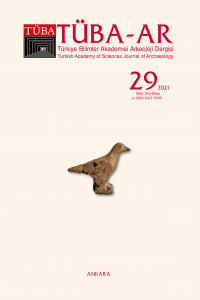DOĞU OVALIK KİLİKYA'DA DEMİR ÇAĞ - OSMANİYE ARAŞTIRMASI DEMİR ÇAĞ SERAMİKLERİ ÖN DEĞERLENDİRMESİ
Doğu Ovalık Kilikya Bölgesi'nde yapılan son araştırmalar bölgenin Demir Çağ tarihine ilişkin yeni bilgiler sunmaktadır. 2005 yılından beri yürütülen Osmaniye Arkeolojik Yüzey Araştırması Neolitik dönemden Ortaçağ'a kadar dönemlere ait değişik kültür malzemeleri taşıyan 40 höyük yerleşimini belgelemiştir. Bu çalışmada, araştırmanın tespiti Demir Çağ seramikleri incelenerek Osmaniye ve bölge dışında tespit edilmiş olanlar ile kıyaslanacaktır. Her ne kadar, komşu bölgelerden etki sürekli ve güçlü olsa da, bu incelemenin sonuçları, siyasi ve ekonomik olarak bölgede hüküm sürmüş ve yerel halka tezat çok fazla yazılı kaynak bırakmış Asur, Grek, Fenike, Kıbrıs ve Pers gibi yabancı kültürlerinin etkileri altında olmayan farklı geleneklerin varlığını vurgulamaktadır. Çalışma, Yüzeyden derlenmiş seramik örneklerin kesin zaman dizinsel tanımlanmasında çok dikkatli olmak gerekse de, güvenli kültür tabakalarından edinilmiş malzemeler ile karşılaştırmalı bir inceleme yaparak çok değerli bilgi sağlamaktadır.
Anahtar Kelimeler:
Ovalık Kilikya, Osmaniye, Demir Çağı, Seramik, Höyük
THE IRON AGE IN EAST PLAIN CILICIA - A FIRST ASSESSMENT OF THE IRON AGE POTTERY FROM THE OSMANIYE SURVEY
New investigations in the region of the East Plain Cilicia offer remarkable insights into the Iron Age history of this ™ region. The Osmaniye Archaeological Survey, being conducted since 2005, comprises more than 40 archaeological mounds that have yielded a large variety of material culture, from the Neolithic period to medieval times. In this article, the Iron Age pottery of the survey will be analyzed and compared with other sources from Osmaniye, as well as from the surrounding areas. Even though the influences of the neighboring areas were continuous and strong, the results of this analysis emphasize the existence of different traditions, mostly independent of the influences offoreign cultures, such as the Assyrian, Greek, Phoenician, Cypriot, and Persian cultures that dominated the area politically or commercially and, unlike the local population, left a large quantity of written sources. Although the pottery survey should be handled with care regarding definite chronological statements, it provides highly valuable information through comparative analysis with stratified material
Keywords:
Plain Cilicia, Osmaniye, Iron Age, Pottery, Mound,
___
- ARSLAN, N. 2011. Kilikya Demir Çağ Seramiği. İthal Boyalı Seramikler ve İlişkiler. İstanbul.
- BING, J. 1969. A History of Cilicia during the Assyrian Period (Indiana University Unpublished PhD Thesis). Ann Arbor.
- CANEVA, I/SEVİN, V. 2004. Mersin-Yumuktepe: A. Reappraisal. Galatina.
- CASABONNE, O. 2004. La Cilicie à L'époque achéméninde. Paris.
- ÇAMBEL, H. 1999. Corpus of the Hieroglyphic Luwian Inscriptions I I: Karatepe-Aslantaş. Untersuchungen zur indogermanischen Sprach- und Kulturwissenschaft 8.2. Berlin.
- ÇAMBEL, H/ÖZYAR, A. 2003. Karatepe-Aslantaş. Azatiwataya. Die Bildwerke. Mainz.
- COLDSTREAM, J. N. 1977. Geometric Greece. London.
- DUPRÉ, S. 1983. La céramique de l'Âge du Bronze et de l'Âge du Fer. Paris.
- FUCHS, A. 1994. Die Inschriften Sargons II. aus Khorsabad. Göttingen.
- GARSTANG, J. 1937. Prehistoric Mersin. Oxford.
- GARSTANG, J.1953. Prehistoric Mersin. Yümüktepe in Southeastern Turkey. Oxford.
- GOLDMAN, H. 1950. Excavations at Gözlü Kule, Tarsus. The Hellenistic and Roman Periods. Volume I . Princeton.
- GOLDMAN, H. 1956. Excavations at Gözlü Kule, Tarsus. From the Neolithic through the Bronze Age. Vol. II. Princeton.
- GOLDMAN, H. 1963. Excavations in Gözlü Kule, Tarsus, Vol. III. Princeton.
- GRAYSON, A. K. 1996. Assyrian Rulers of the Early First Millennium BC II (858-745 BC). The Royal Inscriptions of Mesopotamia Assyrian Periods, Vol. 3.Toronto.
- HAWKINS, J.D. 2000. Inscriptions of the Iron Age, in Corpus of Hieroglyphic Luwian Inscriptions. Vol. I . New York.
- KOZAL, E. 2006. Anatolien im 2. Jt. v.u.Z. und die Hinterlassenschaften materieller Kultur aus dem Ostmittelmeerraum, insbesondere Zyperns. Dissertation. Tübingen, in: http:// nbn-resolving.de/urn:nbn:de:bsz:21-opus-24811.
- ORTHMANN, W. 1971. Untersuchungen zur späthethitischen Kunst. Bonn.
- ÖZYAR, A. 2005. Field Seasons 2001-2003 of the Tarsus-Gözlükule Interdisciplinary Research Project. İstanbul.
- YAMADA, S. 2000. The Construction of the Assyrian Empire. A Historical Study of the Inscriptions of Shalmaneser III (859-824 BC) Relating to His Campaigns to the West. Culture and History of the Ancient Near East 3. Leiden.
- ISSN: 1301-8566
- Başlangıç: 1998
- Yayıncı: Türkiye Bilimler Akademisi
Sayıdaki Diğer Makaleler
GÜNEY AİOLİS'DE BİR DAĞ YERLEŞİMİ: MELANPAGOS
ISAURA ANTİK KENTİ'NDEN YAKININDAKİ YERLEŞİM ALANLARINA TAŞINMIŞ KORİNTH BAŞLIKLARI
DOĞU OVALIK KİLİKYA'DA DEMİR ÇAĞ - OSMANİYE ARAŞTIRMASI DEMİR ÇAĞ SERAMİKLERİ ÖN DEĞERLENDİRMESİ
JERF EL-AHMAR EA 30 BİNASI VE YAKINDOĞU'DA PPNA-PPNB'YE GEÇİŞ DÖNEMİNE AİT KAMU BİNALARI
